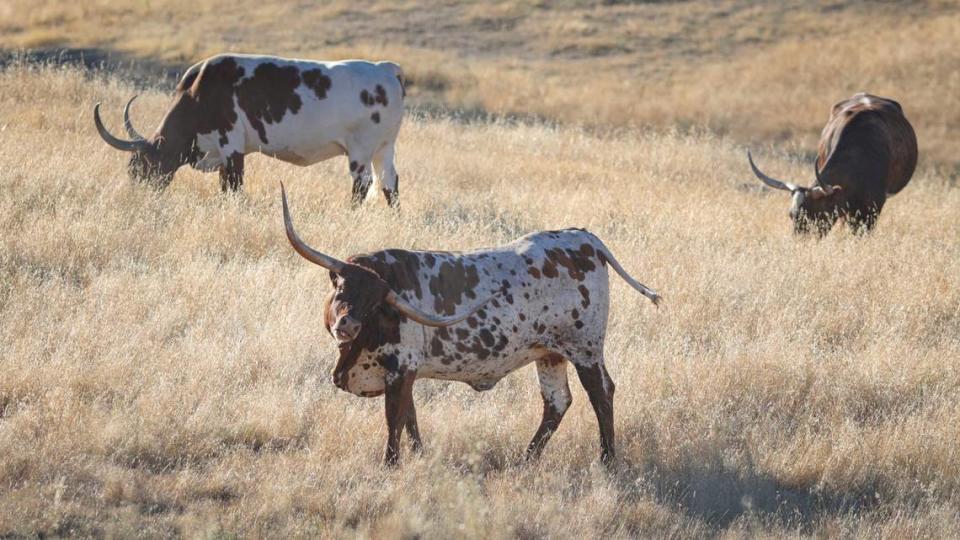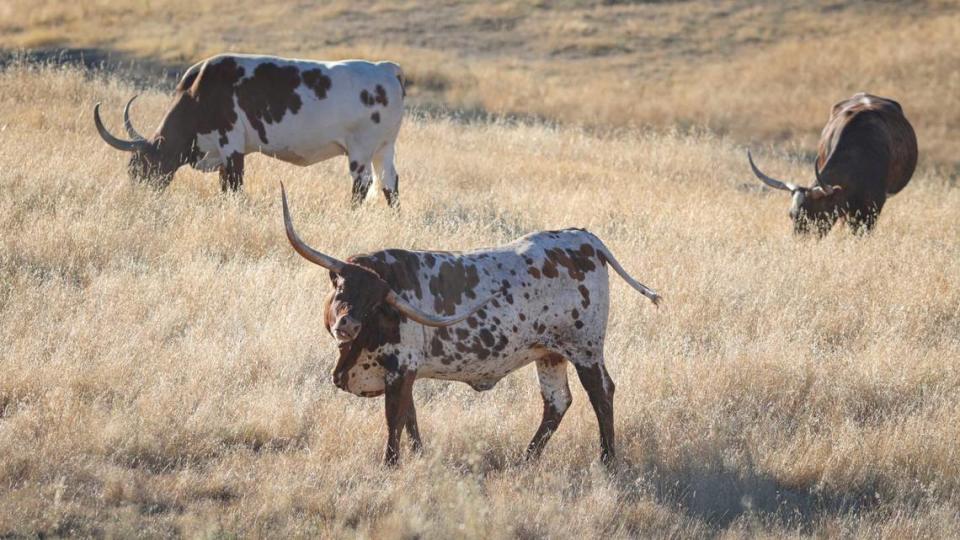As crowds flock to the Central Coast’s pristine beaches this summer, there is one unforgettable scene they are likely to witness as they drive along Highway 101.
Just west of Santa Margarita, Texas longhorn cattle graze along the interstate, their horns piercing the sky as the sun’s rays jet across their backs.
For years, San Luis Obispo County locals have passed by the long-horned beasts and been sent back in time — the golden grass and oak-covered hills dotted by a nowadays rare cattle creating scenes reminiscent of what California might have looked like in days gone by.
But many drivers who take in this scene also have one question: How did those longhorns get there?

Why are there longhorns grazing off Highway 101 in SLO County?
The owner of the cattle, who spoke with The Tribune on the condition of anonymity due to privacy concerns, had a lot to say about where the unique longhorns came from.
For generations, San Luis Obispo County ranchers have grazed cattle throughout the area, a land ripe for raising beef cows.
But what’s less obvious is the importance of grazing the land, to prevent the dry grass from catching ablaze and quite literally adding fuel to wildfires that have proved to spark so easily.

The owner told The Tribune she felt if the land had to be grazed down anyway, it would make sense to fill it with attractive-looking creatures to give people driving along Highway 101 something really beautiful to look at.
“I decided if I was going to graze it, that I would raise it with pretty, pretty cattle,” the owner said. “Everybody gets to see Angus and Holsteins and certainly other types of Herefords, but really we don’t see longhorn herds much.”
“It was all based on aesthetics and beauty and sharing my cattle with the world,” she said.

What kinds of cows are on the ranch?
The owner said nearly all 70 members of the herd on the highway-adjacent property are rescue animals, which include Texas longhorns, Scottish Highlands, Angus and some cross between the species.
Longhorns are known for their exceptionally long horns, while Highland cows are distinct with long fringe that hangs down near their eyes.
The owner, who is vegan and doesn’t participate in the cattle business, stressed that no herd members are eaten, even the Angus.
Many of the livestock have come from other owners who can no longer raise them.
Most recently, the owner took in 32 cattle from Oklahoma — which of course was no small shipping feat, she said. The owner said these cattle then get to continue to “live out their lives” on the ranch.
“Nothing dies, but when they do, we give them a good burial,” the owner said.

History of Texas longhorns
The famous Texas longhorns, known for their exceptionally long horns which can span over 8 feet from tip to tip, have evolved from early African and Spanish herds.
During the Spanish Reconquista, as the Spanish pushed the Arab African Moor people southward, cattle began to roam southern Spain. They were shipped to the New World by the 16th century. Ranching became a foothold in California livelihood for centuries to follow.
“They really are Mexican longhorns, which are actually Spanish longhorns, which are actually derived from the original, African animals,” the owner said.

Cattle have been in this area for about 200 years, the owner said, and during that time the landscape itself has changed drastically.
Different types of grasses have been eliminated as ranchers have grazed the area. The grass growing now has taken over and happens to be really dry, hence the need to keep grass height low as fire season heats up.
“Now that we have people living here, the best thing that most of us can do — as good ranch managers, managers of the land — is to make sure we graze the property and keep that grass down to a reasonable height,” the owner said. “And in order to do that, we graze.”
How to see SLO County’s longhorns
As travelers drive southbound on Highway 101, they should look to their right while approaching the Cuesta Grade.
There they might spot members of the herd, including any of the iconic longhorns as the graze the hills.

EMEA Tribune is not involved in this news article, it is taken from our partners and or from the News Agencies. Copyright and Credit go to the News Agencies, email news@emeatribune.com Follow our WhatsApp verified Channel





